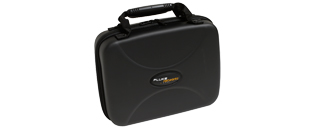CableIQ qualification tester's powerful network troubleshooting capability and intuitive interface enable your frontline technicians to identify and troubleshoot a wider range of problems within your network infrastructure. Is the port active? Are the duplex settings matched? Is it a network problem or a Ethernet cable problem? Can the Ethernet cable support the required network bandwidth? CableIQ network cable tester is the only Ethernet cable tester that can answer all these questions before trouble tickets are escalated to the next level reducing problem escalation by up to 30%.


The network tech's vision into cabling bandwidth
CableIQ qualification tester is the first cabling bandwidth tester for network technicians. This network cable tester It gives even the most novice tech the vision to see what speeds existing cabling can support, quickly isolate cabling from network problems, and discover what is at the far end of any cable. That means network techs can close trouble tickets faster, reduce on-call time, and save money by better utilizing their existing infrastructure.
Qualifies - Tests if your existing cabling has the bandwidth to support voice, 10/100, VoIP or Gigabit Ethernet
Troubleshoots - shows why existing network cabling cannot support the network's bandwidth requirement (e.g. crosstalk at 11 metres)
Discovers - detects what's at the end of any cable and displays device configuration (speed/duplex/pairing)
Identifies unused switch ports that can be reallocated
Graphically maps wiring configuration and shows distance to faults with Intelligent Wiremap
Tests all copper cabling media: twisted-pair, coax, and audio cabling
CableIQ version 1.80 has been released and is now available for download
This requires both the CableIQ Reporter Software 2.0 and the CableIQ Firmware 1.80 to complete the update. The details on how to perform the update and the files can be found here on Fluke Networks Website.
Reduce escalated problems by as much as 30%
CableIQ qualification tester's powerful troubleshooting capability and intuitive interface enable your frontline technicians to identify and troubleshoot a wider range of problems within your infrastructure. Is the port active? Are the duplex settings matched? Is it a network problem or a cable problem? Can the cable support the required network bandwidth? CableIQ network cable tester is the only tool that can answer all these questions before trouble tickets are escalated to the next level reducing problem escalation by up to 30%.
To view a product demo of the CableIQ Qualification Tester, please Click Here
Bandwidth Qualification
When you deploy Voice over IP (VoIP) or Gigabit Ethernet, you want to make sure that the existing cabling will support the bandwidth requirements of your new equipment. Your cabling was certified, but moves adds and changes have rendered many links incapable of running desired speeds. CableIQ quickly reveals whether a link, including patch cords, is qualified for voice, 10/100BASE-T, VoIP, or Gig. Knowing your cabling's bandwidth capabilities before upgrading can prevent countless hours of future downtime and labor hours wasted on unnecessary troubleshooting.
See what speeds your existing cabling can support.
CableIQ's four-second Autotest clearly indicates with a check mark which speeds and applications the tested cable can run.
Cable Troubleshooting
Plug into any cable, patch panel, or wall jack and see both the cable details (length/wiremap) and far-end device details (speed/duplex settings) at once. A series of both cable and network test functions help you isolate connectivity problems. For instance, if Discover mode shows duplex settings are matched but the problem persists, run Autotest to see if the cabling can support the required bandwidth. If a link is not qualified, CableIQ provides detailed information on the nature and location of cabling performance faults such as crosstalk or large impedance changes. With CableIQ your techs can close trouble tickets faster by cutting cable troubleshooting time in half.
Troubleshoot cabling faults in half the time.
This screen shot represents a cabling link that did not qualify for 1000BASE-T because of a connection fault at 4.1 metres.
Infrastructure Discovery
Free up 10% or more of your switch ports
CableIQ's Discover mode shows you exactly what's at the far end of any cable. At the switch, test each cable one at a time. You can quickly see whether the cable is open at the far end, or is connected to a PC. Or use CableIQ's hub blink feature from the workstation to flash the corresponding switch port LED. You may be surprised at how many unused ports you can free up and redeploy using CableIQ.
Determine where installed cables are routed, all from one location.
Attach Remote ID's in different locations, then perform multiple cable tests from the distribution center or wiring closet. CableIQ provides the wiremap, pair lengths, distance to fault, and remote ID number of each tested cabling link.
Intelligent Wiremap
Intelligent wiremap tests for length, shorts, split pairs or opens and displays with an intuitive graphical interface where a fault is located.
CableIQ's Intelligent Wiremap shows pin 6 open at far end of tested cable (130 ft/34 metres).
IntelliTone Technology
Locate cables and wires with superior accuracy
CableIQ supports IntelliTone digital toning by:
Finding cables easier and tracing with better accuracy than any other tool on the market
Toning and tracing safely on a live network
Providing two digital tones and four analog tones
Featuring IntelliTone cable mapping; after tracing, use the IntelliTone Pro Probe 200 to verify wiremap
Easy-to-use
Empower frontline techs with an easy-to-use-tool
Intuitive user interface and graphical display guides user with little or no training required.
Rotary knob makes learning easy and operation simple you always know what test mode is selected
Portable, lightweight, rugged ergonomic design for easy field use
Four AA batteries - Long lasting battery life for several weeks of testing
Remote adapter doubles as a protective endcap.
Customer quote: "I handed CableIQ to our level III techs, they turned the unit on and began testing within two minutes of reviewing the various available selections." --Telecommunications Analyst
CableIQ Kit Choices
To maximize the value of your CableIQ ownership, choose one of our specialized kits. Each kit is tailored for qualification testing in specific work environments shown below in a convenient comparison chart.
What is Qualification?
Qualification is a new category of testers designed to meet the emerging needs of network technicians who need to upgrade to higher network speeds as well as troubleshoot connectivity problems. Qualification testers, like Fluke Networks new CableIQ Qualification Tester, determines if an existing cabling link can or can not support certain network speeds and technologies. This differs from certification testers, like the DTX CableAnalyzer, which guarantees cabling installations comply with TIA/ISO performance standards and basic verification testers, like the MicroScanner Pro, which tests if the cable is connected correctly.
Qualification testers allow network technicians to perform a series of troubleshooting steps to better isolate cabling from network problems. For example, a first step in troubleshooting a network connectivity problem might be to check the speed and duplex settings of connected devices. If the tester shows the settings are matched, but the problem persists, a qualification test can be performed. Performing a qualification test will allow the technician to identify whether insufficient cabling bandwidth is the cause of the problem. Knowing your cabling's bandwidth capability allows you to close trouble tickets faster and helps ensure seamless upgrades to higher network speeds.
Choosing the right tool for the job
When to use a qualification tester: If you are a network technician, and need to see whether the existing cabling will support your 1000BASE-T network, a qualification tool is the right choice. If you need to troubleshoot connectivity problems and isolate cabling problems from network problems, then qualification is the perfect solution. If you have an existing network and are doing small adds, moves, and changes, or are setting up a temporary network and just need to qualify it for a specific network technology, a qualification tool is a good option.
When to use a certification tester: If you're a commercial installer or network owner who needs to prove that all cabling has been installed correctly, and meets TIA or ISO link specifications, you must certify it. If you are in a troubleshooting environment, and need to show unequivocally that the link under test is failing category 5e or 6 performance requirements according to TIA or ISO standards, your only choice is a certification tool. If you have a mixture of fibre and copper cabling, and often need to test both, cable certification tools do that best.
To receive the support and financial security of a manufacturer's warranty, certification to TIA/ISO standards is your only option. Anything else makes the installer liable for the performance of the installation which can be quite costly. For example, a large 1000 link installation could represent a $100,000 (USD) project, which can be a hefty liability if manufacturer warranty is not obtained.
When to use a verification tool: Verification tools are typically used by any technician who pulls and terminates cable or performs basic moves, adds and changes. These tools are used as a first line of defense in finding connection and wire-pairing faults.



CableIQ Advanced IT Kit
The CableIQ Advanced IT Kit is designed to maximize the efficiency of any cable qualification job. Use the included IntelliTone 200 Probe to find cables quickly and definitively, even on active networks. Use the included six smart cable IDs to perform a high volume of qualification tests in a short period of time. Each smart ID has the capability to perform a simple wiremap test or a full qualification test. Up to seven qualification tests can be performed without returning to the patch panel. The rugged carry case can be used to easily port tools from one job to another.
CableIQ Advanced IT Kit Includes: CableIQ main unit with remote adapter, CableIQ Reporter software CD, IntelliTone 200 Digital Probe, Remote IDs #2-7, (2) RJ45-RJ45 patch cord, USB cable, coax F push-on adapter, 75-ohm coax patch cord, RJ45/11 universal coupler, RJ11-RJ11 patch cord, owners CD and quick start guide, (4) AA batteries, test accessory soft pouch, hard carry case.
CableIQ version 1.80 has been released and is now available for download
This requires both the CableIQ Reporter Software 2.0 and the CableIQ Firmware 1.80 to complete the update.
Bandwidth Qualification
When you deploy Voice over IP (VoIP) or Gigabit Ethernet, you want to make sure that the existing cabling will support the bandwidth requirements of your new equipment. Your cabling was certified, but moves adds and changes have rendered many links incapable of running desired speeds. CableIQ quickly reveals whether a link, including patch cords, is qualified for voice, 10/100BASE-T, VoIP, or Gig. Knowing your cabling's bandwidth capabilities before upgrading can prevent countless hours of future downtime and labor hours wasted on unnecessary troubleshooting.
Cable Troubleshooting
Plug into any cable, patch panel, or wall jack and see both the cable details (length/wiremap) and far-end device details (speed/duplex settings) at once. A series of both cable and network test functions help you isolate connectivity problems. For instance, if Discover mode shows duplex settings are matched but the problem persists, run Autotest to see if the cabling can support the required bandwidth. If a link is not qualified, CableIQ provides detailed information on the nature and location of cabling performance faults such as crosstalk or large impedance changes. With CableIQ your techs can close trouble tickets faster by cutting cable troubleshooting time in half.
Infrastructure Discovery
Free up 10% or more of your switch ports
CableIQ's Discover mode shows you exactly what's at the far end of any cable. At the switch, test each cable one at a time. You can quickly see whether the cable is open at the far end, or is connected to a PC. Or use CableIQ's hub blink feature from the workstation to flash the corresponding switch port LED. You may be surprised at how many unused ports you can free up and redeploy using CableIQ.
Determine where installed cables are routed, all from one location.
Attach Remote ID's in different locations, then perform multiple cable tests from the distribution center or wiring closet. CableIQ provides the wiremap, pair lengths, distance to fault and remote ID number of each tested cabling link.
Intelligent Wiremap
Intelligent wiremap tests for length, shorts, split pairs, or opens and displays with an intuitive graphical interface where a fault is located.
CableIQ's Intelligent Wiremap shows pin 6 open at far end of tested cable (130 ft/34 metres).
IntelliTone Technilogy
Locate cables and wires with superior accuracy
CableIQ supports IntelliTone digital toning by:
Finding cables easier and tracing with better accuracy than any other tool on the market
Toning and tracing safely on a live network
Providing two digital tones and four analog tones
Featuring IntelliTone cable mapping; after tracing, use the IntelliTone Pro Probe 200 to verify wiremap
Easy-to-use
Empower frontline techs with an easy-to-use-tool
Intuitive user interface and graphical display guides user with little or no training required.
Rotary knob makes learning easy and operation simple you always know what test mode is selected
Portable, lightweight, rugged ergonomic design for easy field use
Four AA batteries - Long lasting battery life for several weeks of testing
Remote adapter doubles as a protective endcap.
Customer quote: "I handed CableIQ to our level III techs, they turned the unit on and began testing within two minutes of reviewing the various available selections."
--Telecommunications Analyst
CableIQ Kit Choices
To maximize the value of your CableIQ ownership, choose one of our specialized kits. Each kit is tailored for qualification testing in specific work environments, shown in a convenient comparison chart.
What is Qualification?
Qualification is a new category of testers designed to meet the emerging needs of network technicians who need to upgrade to higher network speeds as well as troubleshoot connectivity problems. Qualification testers, like Fluke Networks new CableIQ Qualification Tester, determines if an existing cabling link can or can not support certain network speeds and technologies. This differs from certification testers, like the DTX CableAnalyzer, which guarantees cabling installations comply with TIA/ISO performance standards and basic verification testers, like the MicroScanner Pro, which tests if the cable is connected correctly.
Qualification testers allow network technicians to perform a series of troubleshooting steps to better isolate cabling from network problems. For example, a first step in troubleshooting a network connectivity problem might be to check the speed and duplex settings of connected devices. If the tester shows the settings are matched, but the problem persists, a qualification test can be performed. Performing a qualification test will allow the technician to identify whether insufficient cabling bandwidth is the cause of the problem. Knowing your cabling's bandwidth capability allows you to close trouble tickets faster and helps ensure seamless upgrades to higher network speeds.
Choosing the right tool for the job
When to use a qualification tester: If you are a network technician and need to see whether the existing cabling will support your 1000BASE-T network, a qualification tool is the right choice. If you need to troubleshoot connectivity problems and isolate cabling problems from network problems, then qualification is the perfect solution. If you have an existing network and are doing small adds, moves, and changes, or are setting up a temporary network and just need to qualify it for a specific network technology, a qualification tool is a good option.
When to use a certification tester: If you're a commercial installer or network owner who needs to prove that all cabling has been installed correctly and meets TIA or ISO link specifications, you must certify it. If you are in a troubleshooting environment, and need to show unequivocally that the link under test is failing category 5e or 6 performance requirements according to TIA or ISO standards, your only choice is a certification tool. If you have a mixture of fibre and copper cabling and often need to test both, cable certification tools do that best.
To receive the support and financial security of a manufacturer's warranty, certification to TIA/ISO standards is your only option. Anything else makes the installer liable for the performance of the installation which can be quite costly. For example, a large 1000 link installation could represent a $100,000 (USD) project, which can be a hefty liability if manufacturer warranty is not obtained.
When to use a verification tool: Verification tools are typically used by any technician who pulls and terminates cable or performs basic moves, adds and changes. These tools are used as a first line of defense in finding connection and wire-pairing faults.


- Review: The 10 Best Wireless Access Points
- Review: The Top 10 Best Ethernet Cables
- What Is An Ethernet Cable And What Does It Do?
- 10 Best CCTV Security IP Cameras For Home & Business
- Review: Best Powerline Adapters In The UK
- Celebrating 20 Years Of Comms Express!
- The Top 10 DrayTek Wireless Access Points
- Best Selling APC Products At Comms Express
- Review: Top 5 Best Performing APC Uninterruptible Power Supply Units (UPS)
- Review: Top 10 Best PDU’s













